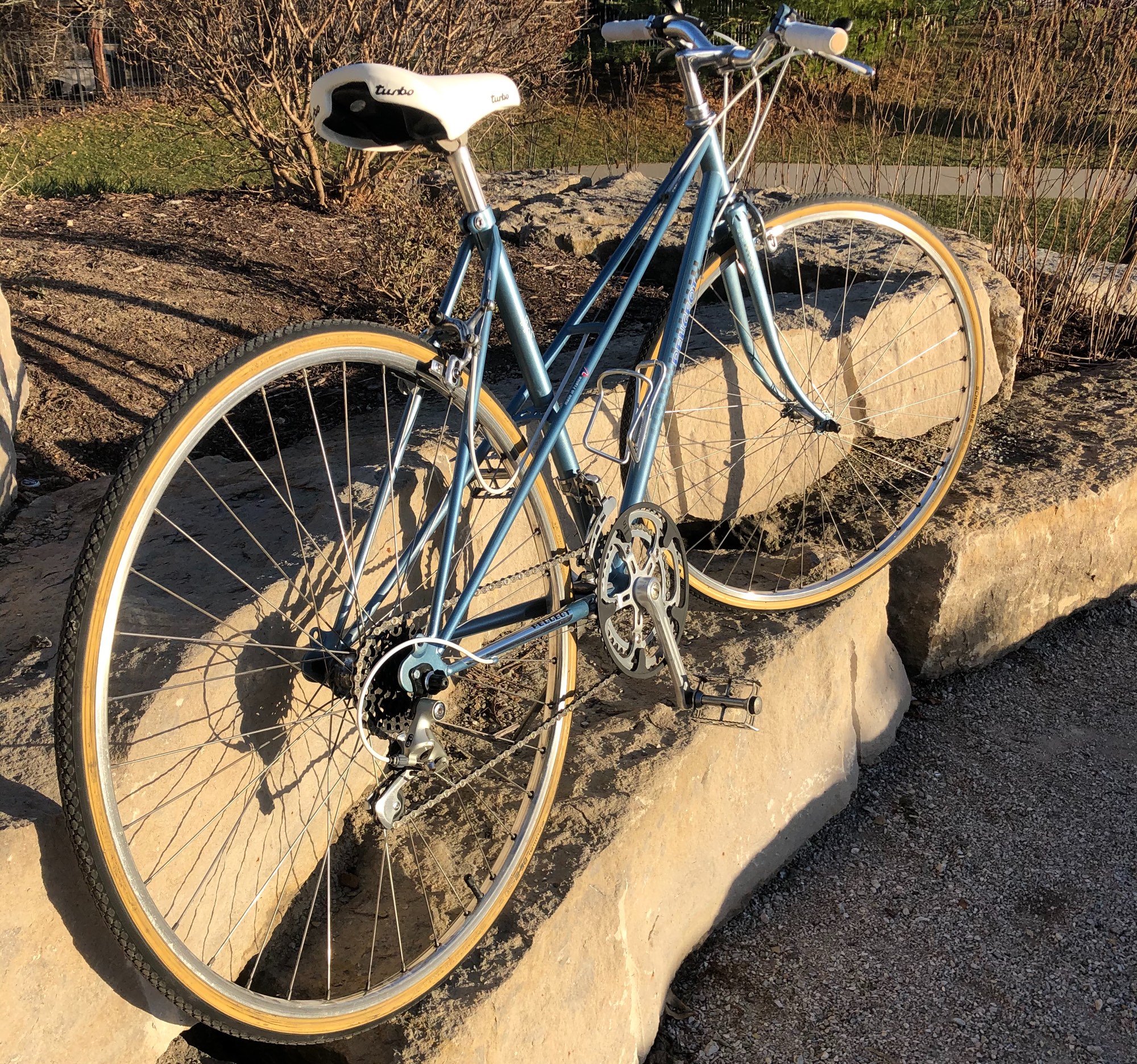For awhile now I've been on the hunt for a nice step-through framed bike. My criteria weren't that tough: be pretty, and not terrible. Apparently in the world of step-through frames that seems to be a tall order.
The fact is step-through frames -- even mixtes -- still have way too much of a "girl bike" stigma, and cycling in general has a tendency to treat women (and "girl bikes") as second-class members of the community. You see it all the time: some guy is out front with the latest carbon-fiber Terminator 6000 SEX 40-speed wonder while his girlfriend/spouse lags behind on a 500-pound cruiser, struggling to keep pace, 'cause he's much more serious a cyclist.
Hang on, it's hard to type with my eyes rolling so far into the back of my head.
Anyways, back to the subject at hand: the difficulty in finding a decent step-through frame. I had been looking awhile, but nothing quite worked.
I narrowly missed a pair of nice Bianchis, much to my chagrin. I had an eye on two different Raleighs, but neither quite spoke to me. And I suspect both may have been real heavyweights -- not what I was after. I spotted a nice Miyata and a Univega, but both weren't really priced like project bikes (although the Univega should have been).
Finally, on a whim I inquired about this forlorn Peugeot that had been listed on the local marketplace a full year ago. Astoundingly, it was still available, and could be mine for couch-cushion money. So I grabbed it.
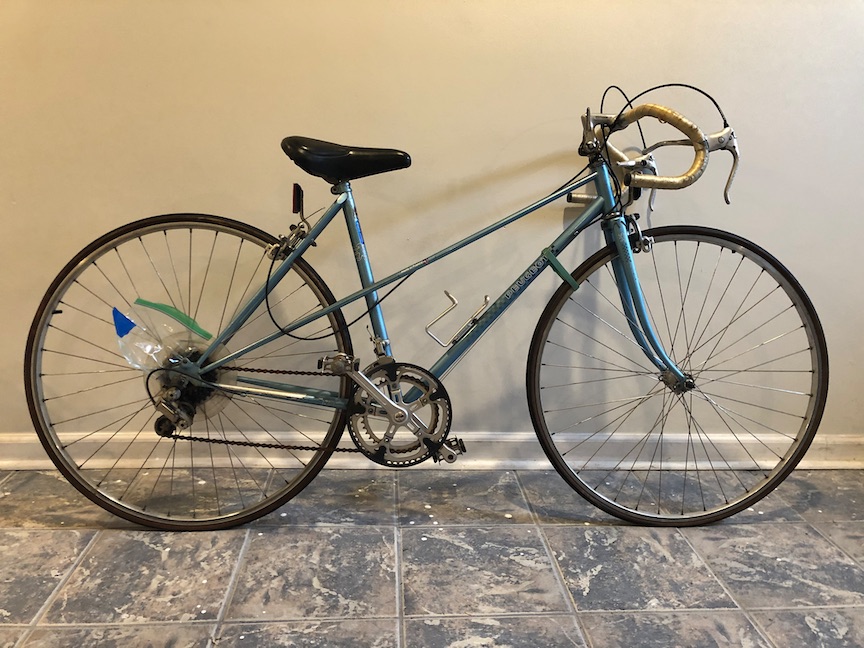
To be honest, it's not a great Peugeot. It's an OK Peugeot. I thought it was pretty and nice enough. After some research (and discovering the paper tag still intact on the bottom bracket) I learned this particular Peugeot is something of a rare bird (or lion, as the case may be): it's a circa 1982 PH19, as seen on this catalog page and this ad.
From those artifacts I gathered the PH19 was the mixte variant of the PH10. While the PH10 lasted a few years, I can't find any reference to the PH19 mixte variant after 1982. My guess is that Peugeot had too many mixtes in the mix and the PH19 was squeezed out.
The PH10 and PH19 are a bit unusual for the era, too. Where their contemporaries would have had lugged frames, these Peugeots were lugless and internally brazed. Peugeot made a bit of a fuss about it at the time, claiming a step forward, but I could also see where it was simply a cost-cutting measure. Hard to say nearly 40 years later.
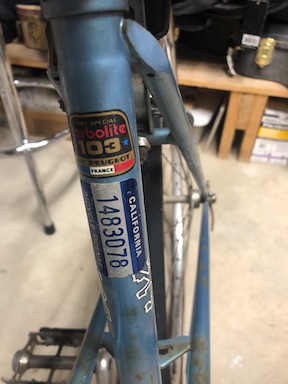


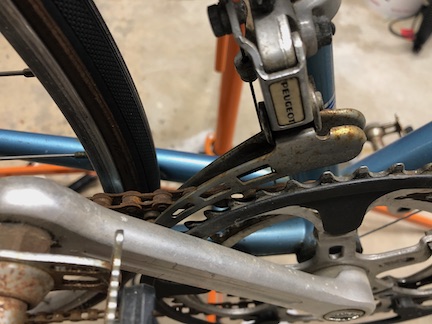

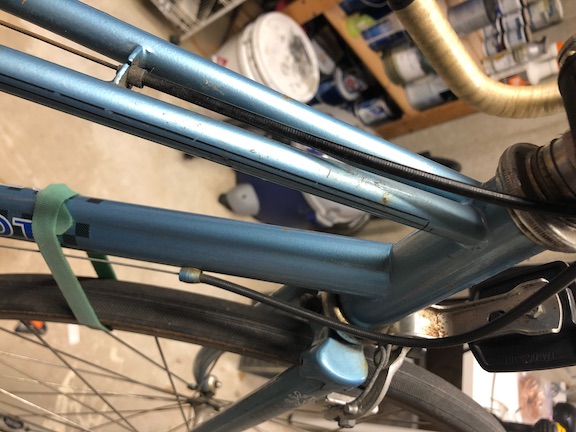

November 2020: Paint#
I knew when I bought the Peugeot it had some rust. I underestimated the extent of it. I should know better. I've made this mistake before. I'll probably make it again.
Nevertheless, as I cleaned and scrubbed the bike I was clearly losing more and more of the original metallic blue paint until eventually I was clearly going to have to spray some paint.

I hoped to do a partial respray, but matching the light blue metallic proved difficult. Hobby stores couldn't help, and eventually I turned to pricey automotive paint. A local auto paint supply store custom mixed it for me, taking a color analysis of the fork I took in. Auto paint is high quality stuff, but the paint cost me three times what I paid for the bike. And they warned me it still might not be an exact match. It's tough color matching metallics. Any number of factors will throw it off, including temperature, humidity, and my own paint technique.
But I had to try, and I dutifully taped off all the stickers and pinstriping and otherwise prepped the frame for spot painting.



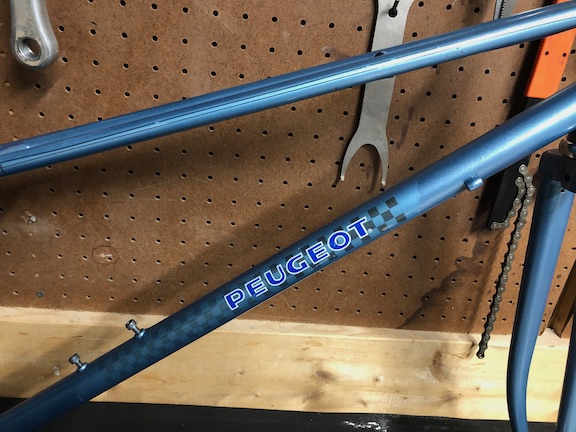
It didn't work. No matter how I buffed and color sanded, there was a clear difference between the new and old paint and it was not going to feather in smoothly.
Sigh.
I was going to have to do a full respray. Which meant replacing all the graphics. I was convinced I'd never find the correct stickers and would have to bodge something together to make the Peugeot together.
Luckily I found the absolutely correct set of decals for this obscure Peugeot. While I had to wait for them to come all the way from the UK, they were beautifully done, and I can happily recommend bicyclestickers.co.uk for any sticker needs.

Before I sprayed (again) I sanded everything back even more than I did the first time, and carefully measured the position of the existing decals, with lots of pictures.
I really wanted to put it back together looking as close to original as possible, and once I had sanded and painted I wouldn't be able to see where they went. So I figured I'd better get it right before I went any further.
Once prepped, it went out again for priming and painting. After letting the paint dry and harden a few days, I polished it up with Turtle Wax polishing compound to bring out the shine.

And that worked. The original rust damage was invisible, and you could never tell the paint is a slightly different shade than the original. While I'm no professional painter, I'm very happy with how it came out.
December 2021: Rebuilding and enjoying the Peugeot#
As I waited on the new decals to make their way across the pond from bicyclestickers.co.uk, I started work on all the components.
I could tell the bike had been truly loved once. That had been awhile ago, though, and things were looking rough. It took a lot of time, effort and polishing compound.
It's not perfect by any stretch, but it has a nice blend of shiny new and vintage patina, and it positively oozes Gallic charm. It's the kind of bike that makes you want to buy more just like it, even though you clearly already have one and don't need more.
But that's the finished product. It took a lot to get there, as you can see in the before-and-after photos.
Let's start with the rust. As noted previously, the rust on the frame wasn't deep, but it was extensive. Worse yet, the more I stripped back, the more rust I uncovered.
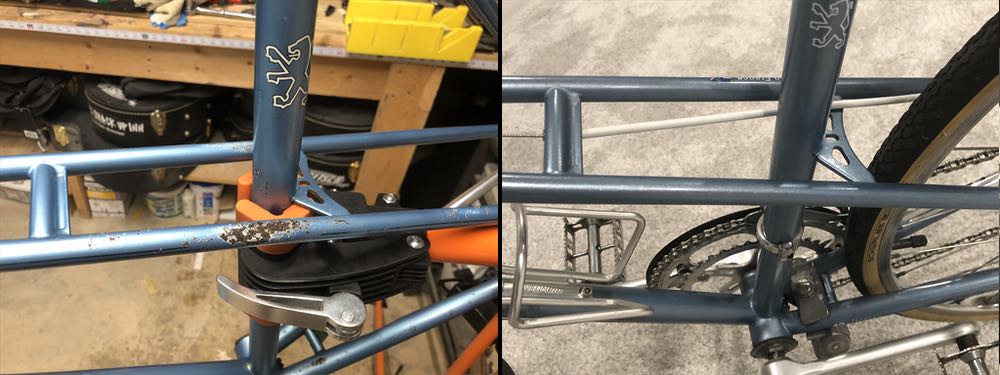
If the bike had rusted from the inside-out then the frame would be junk. I think the California salt air attacked the paint, but not deeply.
In the end, the automotive paint was expensive and worth it. The frame finished up very well, and the reproduction decals completed the look beautifully -- so much so that I picked white accents, including brake lines, to complement the white Peugeot logos.
The PH19 and the closely related (and more common) PH10 were built from Peugeot's proprietary Carbolite 103 high-tensile steel. That should be a recipe for real pig of a bike, but the PH19 rides much lighter and feels lighter than it actually is. Normally I would be a hard pass on most high-tensile steel bikes. I'm glad I gave it a chance.
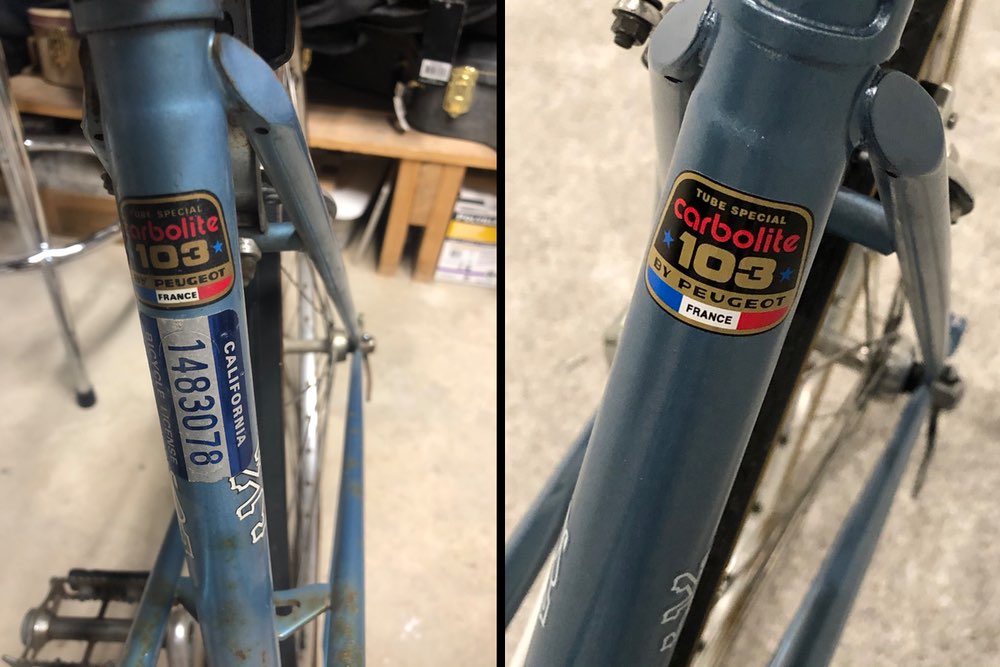
The permit stickers tell us that at some point, long ago, this was a California bike before it found its way to the midwest and began a long period of neglect.
The bottom bracket also showed a good bit of corrosion, but it was all surface rust, with no pits in the steel, and inside the bottom bracket wasn't rusty. It cleaned up well, as did the original Stronglight cranks. I added a new Greenfield kick stand since it's just a kickstand sort of bike.
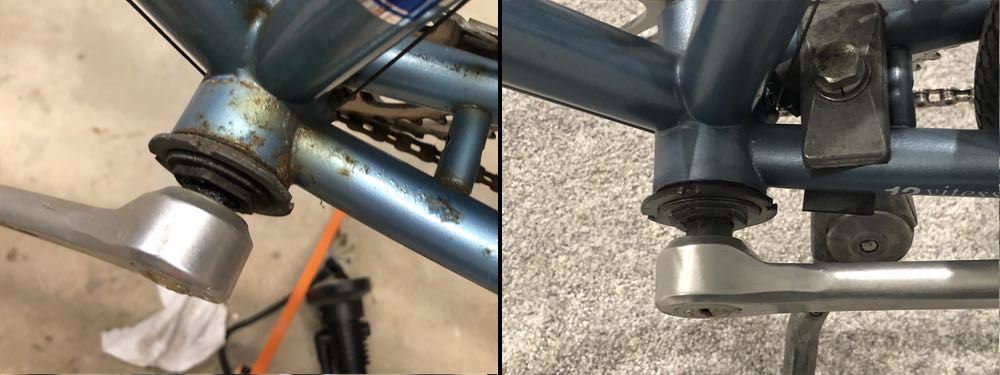
Speaking of the Stronglight cranks, they were one of the few bits that really just had some surface grime on them, so they cleaned up with very little effort. I did, however, have to pick up new chainring bolts since the originals were pretty far gone.
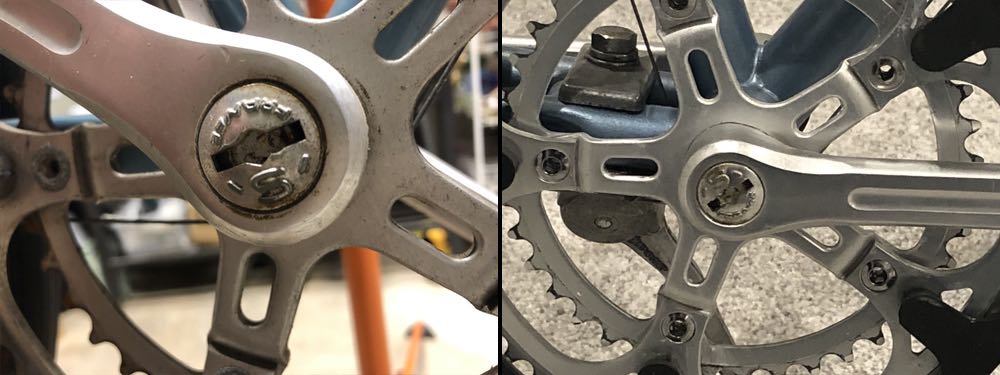
The cranks and chainrings were just quickly dismantled and hit with a bit of Mother's polish and they came out wonderfully. The alloy rings look like they've seen very few miles. Even the black plastic chainguard cleaned up well and was reused.
The front derailleur is Peugeot branded but probably made by Simplex. The Peugeot sticker is a little yellowed, but that's just seems like a bit of patina.
The derailleur itself polished right up and works well. The old chain was a goner, though, so a new KMC silver-finished chain is in place now.
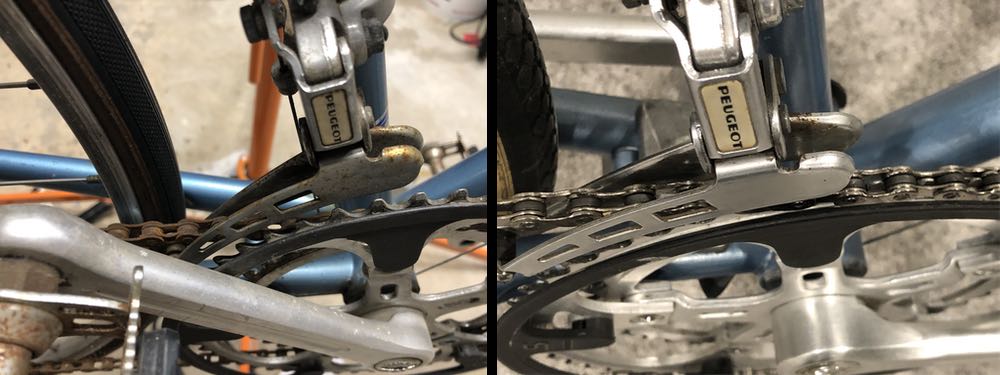
The pedals looked absolutely terrible but they spun freely, had no end-play, and were fairly lightweight. They clearly must have been decent quality when new, and comparable new pedals would be out of the budget for this bike, if I could even find them. So I tried cleaning them up, with OK results.
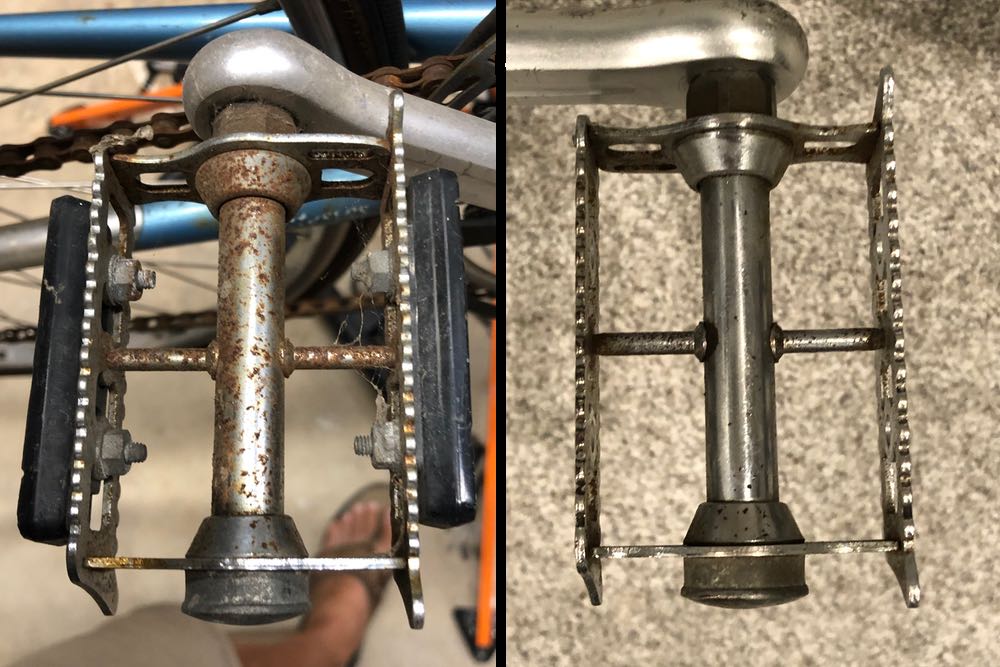
They're far from perfect, but they don't look bad and they still work very well. Of course I went ahead and repacked them with grease. Since pedals tend to get pretty abused, I chose some higher-quality Finish Line grease.
For polishing the pedals and other tight areas where my stubby fingers don't really fit, I picked up a new rotary tool with a flexible shaft extension and it's been one of my smarter recent tool purchases. It's so much easier than trying to polish everything by hand, and this particular rotary tool has impressed me more than several more expensive ones I've had in the past.
It made a huge difference on the hubs and rims. Trying to polish around spokes isn't fun, but the flexible shaft made it go much better.

The Peugeot had Malliard hubs mated to Rigida rims, with Speidel quick-releases. All decent enough, but they were in terrible shape, with a cruddy gray haze everywhere that wasn't covered in oily grime.
The quick releases in particular were pretty rusty. A hard scrubbing with light oil and blue Scotch-brite pads took the rust off, and then they cleaned up well.
Of course I had to buy yet another freewheel tool to remove the Atom cluster for cleaning, and to remove the ugly yellowed plastic pie plate.
The rims were a complete surprise. As I got the grime off I could see that they had a chrome-ish finish. At first I thought -- and fretted -- that they were steel rims.
I was completely surprised to discover that they're definitely aluminum but had apparently originally been highly polished. I was just bringing the shine back to them. Regardless, they look great now.
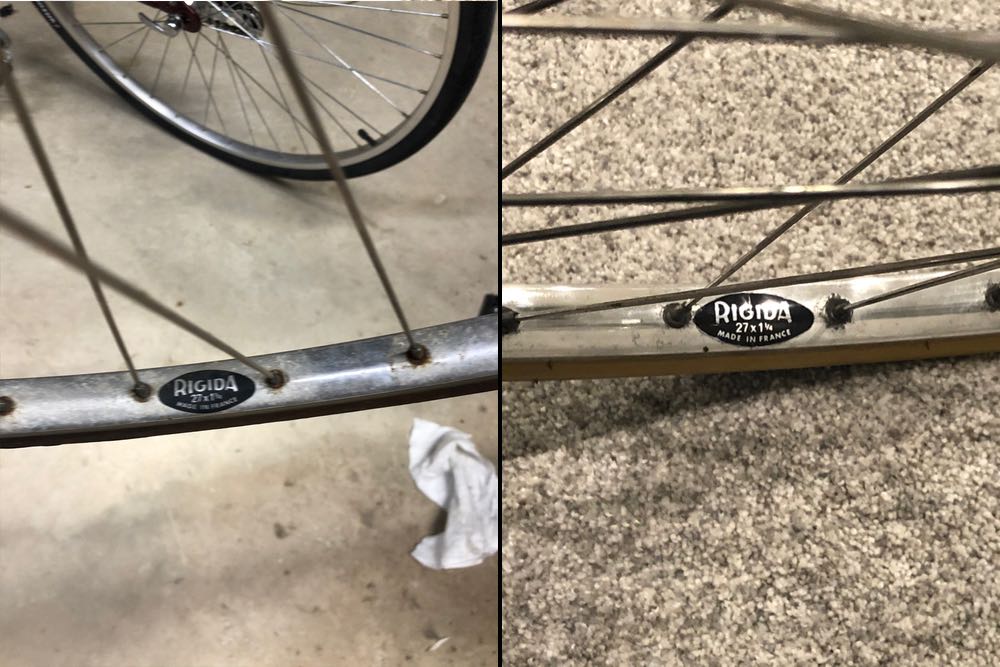
Tires are Schwalbe HS159 with gum walls, because I had them in the parts bin already and they're 27". If I had to buy tires I would have picked Panaracer Paselas in 27", but the Schwalbes are fine and durable.
The original chrome sticker chain stay was looking ragged, so I picked up a Peugeot-branded one from eBay.
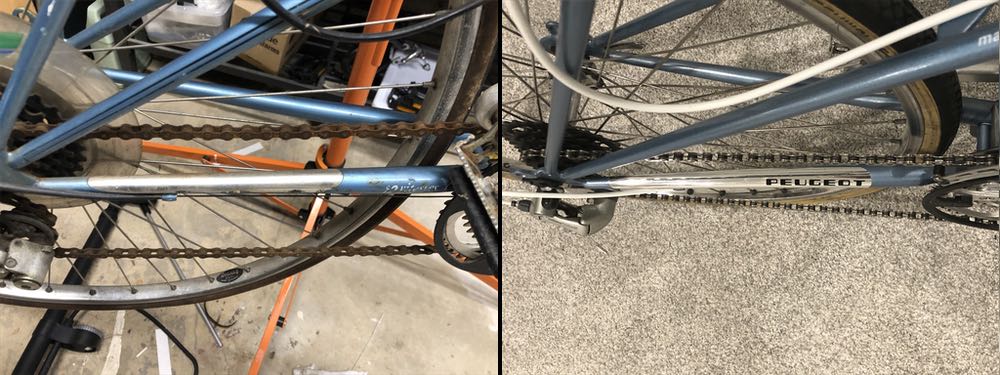
I mistakenly thought the new chainstay protector would be hard chromed plastic, not a thin vinyl sticker, but it works. I also really like the white cables against the metallic French blue paint.
The rear derailleur was an adventure. These old Simplex derailleurs have a reputation for brittle pulley wheels, and my pulley wheel came to me in pieces inside a plastic bag helfully taped to the spokes.
Of course Simplex pulleys are complete unobtainium and the Shimano pulleys I already had laying around don't fit.
After doing some research I learned Suntour pulleys can fit, with some work. I thought it would be simple enough to find a ragged Suntour derailleur to scavenge a pulley from, but then I couldn't find one for a reasonable price.
In the end, it was faster/cheaper/easier to just get a different derailleur, and I found a nice Shimano 105 on eBay for a good price. Then I still had to buy a new hanger because the original was made for the Simplex, which of course uses a different size bolt.
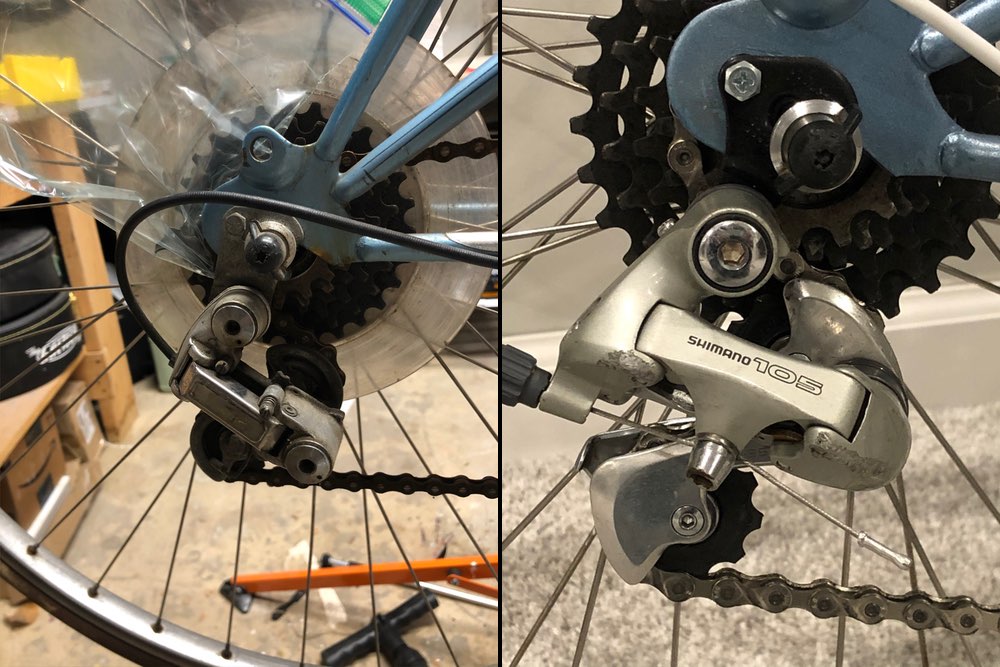
I'm happy with the results. The 105 doesn't look too out of place to my eyes and it shifts fantastically.
Taking a look from the rear, the finished Peugeot shows little touches that weren't readily visible, like a nicely fluted seatpost that polished up well.
Even the seat post bolt was pretty nasty, but it came back surprisingly well with crubby pads, light oil and elbow grease make magic.
A brand-new vintage-style Selle Italia saddle in white (of course) makes a lovely and comfortable topper for all of it. Over the seat you can catch a glimpse of the new cockpit, too.

Taking a closer look at the cockpit, about all the stayed was the original stem and the headset.
The headset needed some light rust removal but the races looked good, so no problems there. The headset spacers had darkened with age, but polished aluminum replacements fixed that.
The original stem took a fine shine, but the stem-mounted shifters went into the parts bin, along with the bars and brake levers, all to make way for converting the original drop-bar configuration to upright bars.

The original-looking celo bar tape went into the trash -- what was left of it, anyway. In their place I fitted Origin8 bars and Tektro FL750 brake levers, same as on the Principessa.
Shifting duties are handled by some Shimano Tourney units, which work shockingly well for the price: $20 for both sides! They work perfectly with the original 2x12 gearing setup, and even have a little blue upshift button that complements the blue paint. I was really surprised at how nice these admittedly bargain-basement shifters turned out.
Grips are simply SRAM cork bar tape in white. I was going to lacquer them but in the end didn't bother. Even clear lacquer would have yellowed them some, and honestly, if they get that dirty, I can just re-wrap them. One box of bar tape would wrap them 2-4 times.
Bar plugs are courtesy of Kendall-Jackson. More on that in an upcoming post.
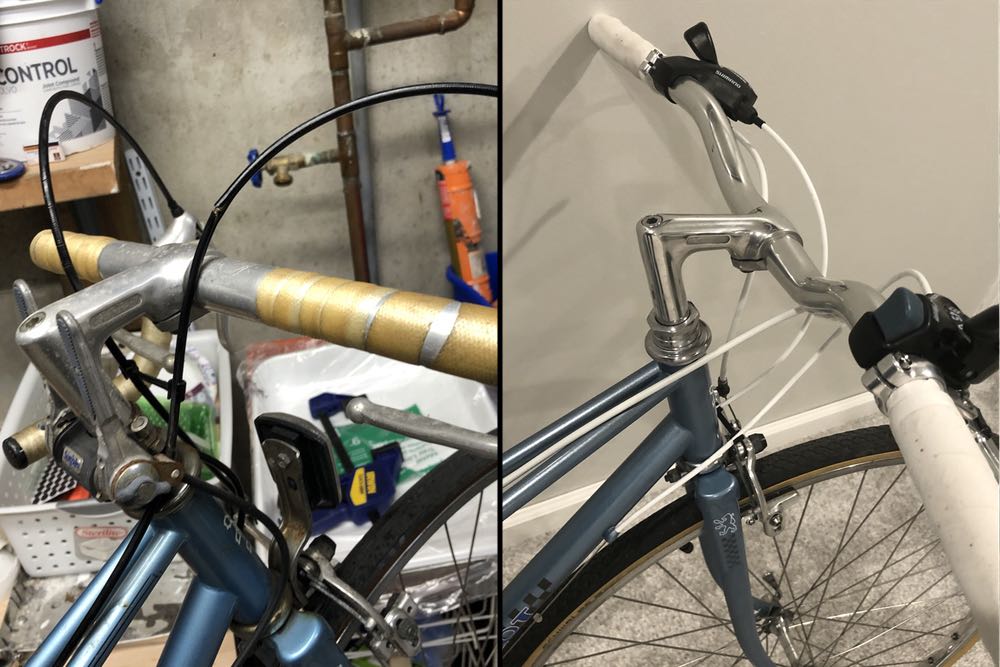
So how does it ride? Wonderfully. It's a beautiful little ride. It's very comfortable, with quick but not flighty handling. The mixte frame looks fantastic, it's easy to get on and off and it's very flingable -- but again, not squirrelly.
It feels like you could ride it all day but you'd have to stop frequently to just enjoy the day with it.
It may have been a surprisingly great bike back in the day, or maybe it's way more than the sum of its parts. Either way, I love this thing. It is, in every sense, a lovely bike. I'm glad it didn't go to the dumpster.
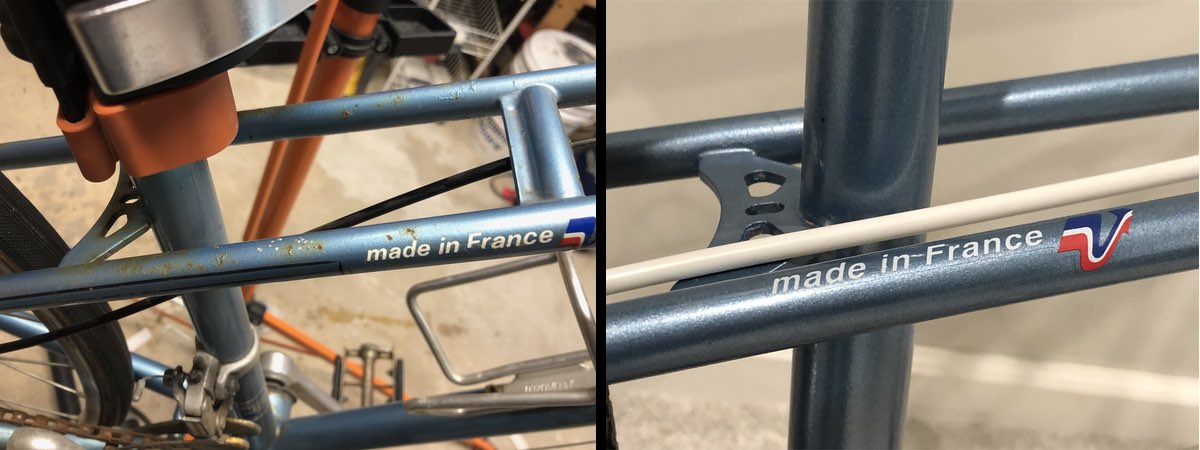

As an Amazon Associate I earn from qualifying purchases. In other words, I get commissions for purchases made through links in this post. When you follow a link and buy something, it doesn't cost you anything extra, but I may make buck or two. So thank you! That said, any recommendations I make are my recommendations, based on my experience, and are not paid endorsements. I only point you toward the stuff I use, and if I don't like it, you'll hear about why.
July 2021 - Goodbye Peugeot#
I kept the Peugeot until late July of 2021 before letting it go to make room for another project. To be honest, almost immediately I regretted letting it go, and that feeling has only intensified since. It remains possibly the prettiest, friendliest commuter/city bike I've built up yet, and I would gladly build up another Peugeot someday. Preferable a mixte.
